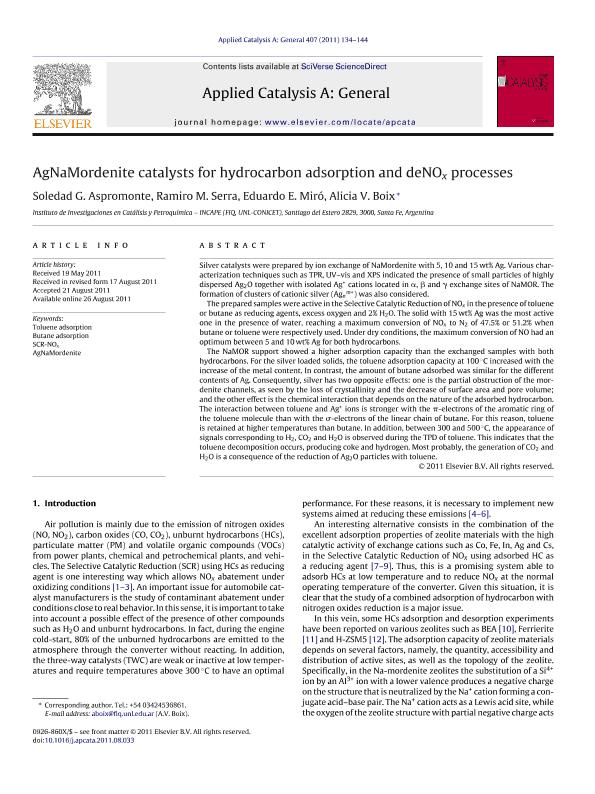Artículo
AgNaMordenite catalysts for hydrocarbon adsorption and deNOx processes
Aspromonte, Soledad Guadalupe ; Serra, Ramiro Marcelo
; Serra, Ramiro Marcelo ; Miro, Eduardo Ernesto
; Miro, Eduardo Ernesto ; Boix, Alicia Viviana
; Boix, Alicia Viviana
 ; Serra, Ramiro Marcelo
; Serra, Ramiro Marcelo ; Miro, Eduardo Ernesto
; Miro, Eduardo Ernesto ; Boix, Alicia Viviana
; Boix, Alicia Viviana
Fecha de publicación:
11/2011
Editorial:
Elsevier Science
Revista:
Applied Catalysis A: General
ISSN:
0926-860X
Idioma:
Inglés
Tipo de recurso:
Artículo publicado
Clasificación temática:
Resumen
Silver catalysts were prepared by ion exchange of NaMordenite with 5, 10 and 15 wt% Ag. Various characterization techniques such as TPR, UV-vis and XPS indicated the presence of small particles of highly dispersed Ag2O together with isolated Ag+ cations located in α, β and γ exchange sites of NaMOR. The formation of clusters of cationic silver (Agnm+) was also considered. The prepared samples were active in the Selective Catalytic Reduction of NOx in the presence of toluene or butane as reducing agents, excess oxygen and 2% H2O. The solid with 15 wt% Ag was the most active one in the presence of water, reaching a maximum conversion of NOx to N2 of 47.5% or 51.2% when butane or toluene were respectively used. Under dry conditions, the maximum conversion of NO had an optimum between 5 and 10 wt% Ag for both hydrocarbons. The NaMOR support showed a higher adsorption capacity than the exchanged samples with both hydrocarbons. For the silver loaded solids, the toluene adsorption capacity at 100 °C increased with the increase of the metal content. In contrast, the amount of butane adsorbed was similar for the different contents of Ag. Consequently, silver has two opposite effects: one is the partial obstruction of the mordenite channels, as seen by the loss of crystallinity and the decrease of surface area and pore volume; and the other effect is the chemical interaction that depends on the nature of the adsorbed hydrocarbon. The interaction between toluene and Ag+ ions is stronger with the π-electrons of the aromatic ring of the toluene molecule than with the σ-electrons of the linear chain of butane. For this reason, toluene is retained at higher temperatures than butane. In addition, between 300 and 500 °C, the appearance of signals corresponding to H2, CO2 and H2O is observed during the TPD of toluene. This indicates that the toluene decomposition occurs, producing coke and hydrogen. Most probably, the generation of CO2 and H2O is a consequence of the reduction of Ag2O particles with toluene.
Palabras clave:
Agnamordenite
,
Butane Adsorption
,
Scr-Nox
,
Toluene Adsorption
Archivos asociados
Licencia
Identificadores
Colecciones
Articulos(INCAPE)
Articulos de INST.DE INVEST.EN CATALISIS Y PETROQUIMICA "ING. JOSE MIGUEL PARERA"
Articulos de INST.DE INVEST.EN CATALISIS Y PETROQUIMICA "ING. JOSE MIGUEL PARERA"
Citación
Aspromonte, Soledad Guadalupe; Serra, Ramiro Marcelo; Miro, Eduardo Ernesto; Boix, Alicia Viviana; AgNaMordenite catalysts for hydrocarbon adsorption and deNOx processes; Elsevier Science; Applied Catalysis A: General; 407; 1-2; 11-2011; 134-144
Compartir
Altmétricas



